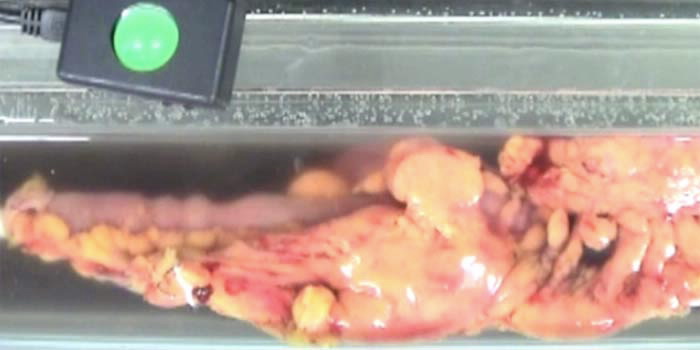The unlikely pairing of a marine biologist and physicist is leading to a renaissance in how we understand a taboo subject -constipation.
When Dr Phil Dinning told Professor John Arkwright where he could shove his newly invented fibre-optic catheter, little did they realise it would revolutionise studies into illnesses such as faecal constipation and incontinence.
Labelled the “Hubble Telescope” of manometry, the innovative catheter has provided a great leap in knowledge into the mechanics of the human digestive system by recording pressures deep within the colon while the patient is fully mobile and conscious.
And for their work into some very socially embarrassing illnesses, the two were awarded with the 2011 Australian Nuclear Science and Technology Organisation (ANSTO) sponsored Eureka Prize for Innovative Use of Technology.
The two scientists were recently invited to share their research at ANSTO in Lucas Heights as part of our Distinguish Lecture series and explain how such an oddball pairing led to a revolution of medical imaging in the colon.
“I started in marine biology so had nothing to do with this field at all,” started Dr Dinning from the Department of Human Physiology at Flinders University.
“I thought optical-fibres were metal and John’s anatomy was appalling so that led to some enormous misconceptions early on and what you could do and what you could put into a human body”.
But they were quick to sort out the misconceptions tackling an area of research that until now was a complete mystery.
Gastrointestinal disorders are a major health issue that have a significant impact on quality of life - affecting an estimated 20 per cent of the Australian population at an annual cost of $US6 billion. Until now, they have been hard to diagnose and cure because of a lack of understanding and accuracy around what exactly is happening inside the gut.
A lot is known about digestion in the upper parts of the body. When we eat peristalsis, or muscle contractions force the food through our digestive system starting at a few seconds in the mouth, and stretching out to a couple of days in the lower part of the stomach, but the further you move through the body, the darker and more confined the space and the less we know.
“So how do we learn about this area?” quizzed Dr Dinning.
“Well, we can do nuclear medicine transit studies. We can get patients to swallow a nuclear radioisotope and plot the bodily controls by taking a snapshot as content moves through the system.
“But this is a snapshot. All it does is say something is wrong. It doesn’t really tell us what’s wrong. “
 |
| The fibre-optic catheter originally designed for measuring pressure inside the oesophagus is now opening up a whole world of research in the colon. To support Dr Phil Dinning's theoretical studies additional in vitro studies were carried out on a human colon prividing real time analysis. |
There are also catheters that offer a record of multiple sites as matter passes through the body but the technology has limited the number of sensors capturing data resulting in ambiguous readings.
It’s here that Professor Arkwright’s imaging device comes into its own.
Using optical physics, Professor Arkwright from CSIRO found a way to get high definition images of a dark part of the human body – the colon.
“I decided Bragg gratings were the way to go. A Bragg reflection is a distributed reflection – you get a whole lot of weak reflection of weakly reflecting interfaces. And if those weak reflecting interfaces are periodic there’s a certain wavelength called the Bragg wavelength that provides a strong back reflection.
Applying this technique to a catheter that could make its way through very confined areas, the former submarine telephone systems developer came up with a pretty useful tool.
“Suddenly you start seeing things that we could not see before,” said Dr Dinning as a result of the breakthrough.
“We didn’t even know these types of patterns existed,” the research said in reference to the muscle contractions that determine the movement of waste through our bodies.
Until now, monitoring devices with a limit of between 16 and 20 sensors were picking up sporadic events in the colon and scientists were not sure if the waves were moving forwards or backwards and at what level.
The new fibre optic catheter was able to use from 32 elements and beyond and was able to detect clusters of events – both antegrade and retrograde. A combination of both these movements determines the transit of content through our bowels.
Dr Dinning says the development of this tool is now leading to entirely new streams of research into the human gut that scientists were previously getting completely wrong.
We’ve not only been publishing events that were wrong, we weren’t even recording what was actually going on so it changes how we look at it.
Eureka prize opens doors
Since winning the ANSTO sponsored award for Innovative Technology has now opened up a world of new possibilities for the technology. As a direct result of the prize, Professor Arkwright has commenced studies into a range of fields including a$1.2m project monitoring water pipes, Snoring and even geothermal temperature profiling.
Published: 23/07/2012


